6 Common Netball Injuries
Top Netball Injuries
Although Netball is not as fast-paced as other sports, it still has loads of potential injury incidents and overuse injuries. If anything, the nature of the sport makes netball players much more susceptible to specific injuries and a lot of injuries are caused by integral parts of the sport such as blocking, sudden stops and turns, jumping and landing.
The rules of Netball, such as the rule about only taking one step and being allowed 3 seconds to pass the ball make movement speed quite slow but with the increased passing, the ball moves around a lot quicker and this is where a lot of hand injuries come into play.
Netball players, therefore, have to keep up and sticking to the rules demands a lot of pivoting and precision positioning which also requires strong leg muscles and this can put a lot of strain on the body.
There are rules that protect players such as allowing minimal physical contact and an emphasis on not allowing any type of contact that endangers a player.
N.B. Please don't attempt to self-diagnose yourself, the information below is provided to help you understand the common injuries in netball. If you suspect you have some of the symptoms, please consult your physician or sports medicine professional for a proper assessment and examination.
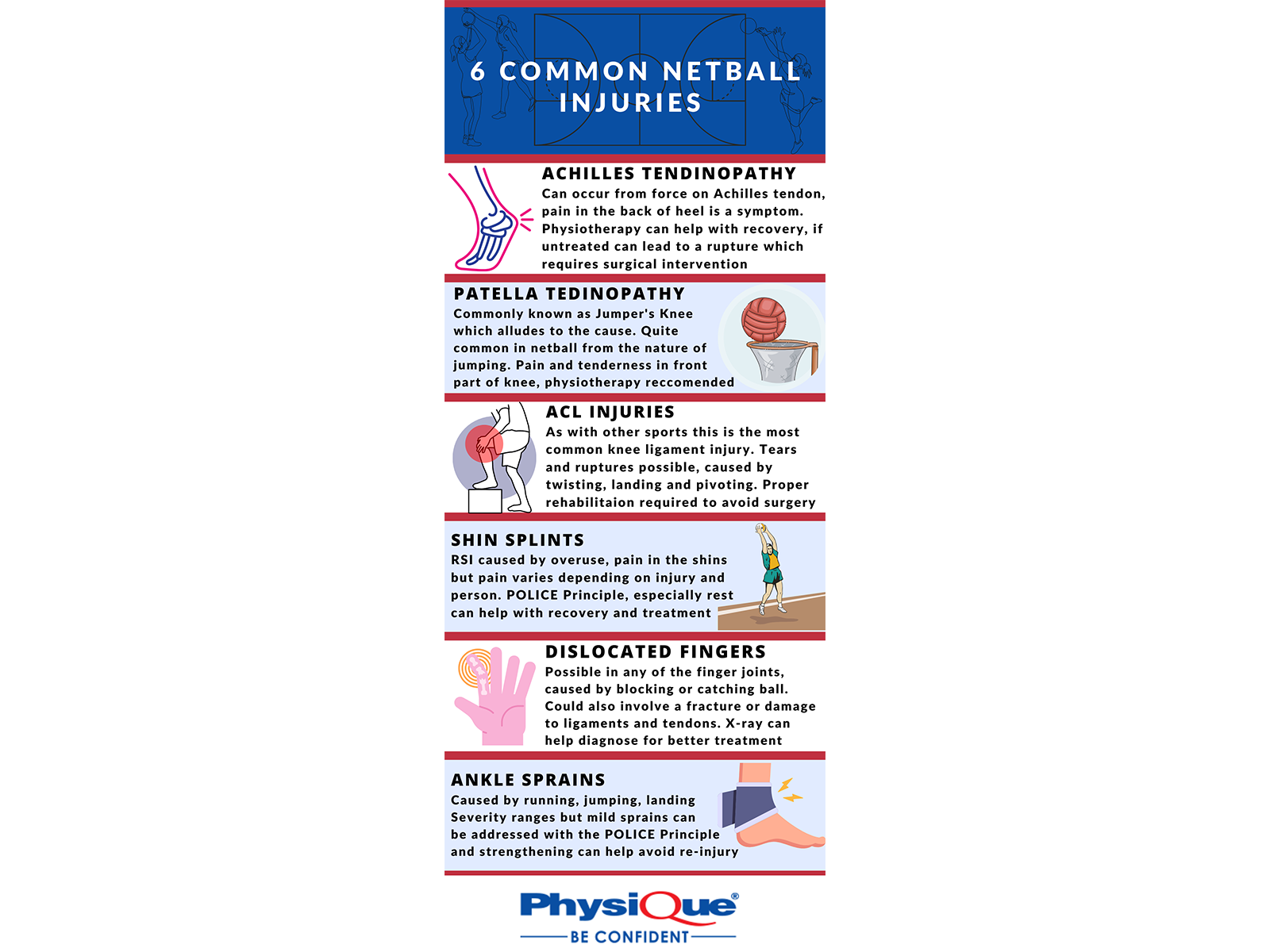
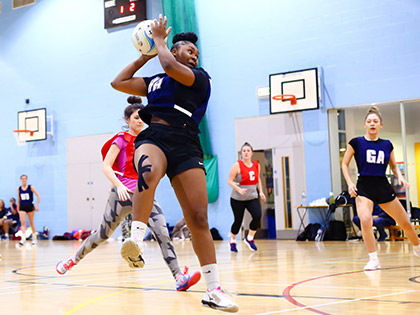
What are common Netball Injuries?
- Achilles Tendinopathy
- Patella Tendinopathy
- ACL Injuries
- Shin Splints
- Dislocated Fingers
- Ankle Sprains
Some other common Netball Injuries include:
- Rotator Cuff Injuries
- Finger Fractures
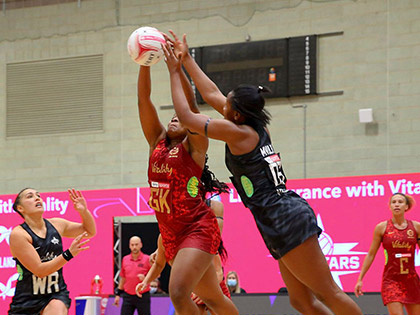
What is the most common Netball Injury?
In a systematic review of 46 studies,[1] it was found that the most common Netball injuries for people older than 16 were upper limb injuries such as sprains, and fractures in the arm, wrist and hand.
For people below the age of 16, lower limb injuries were more common and the injuries included knee and ankle sprains and strains.
Athletes are more likely to pick up injuries than recreational Netball players and this doesn't only refer to overuse injuries.
The most common causes of these injuries are usually trips, falls, landing, jumping and contact with another player.
Can I prevent a Netball Injury?
Unfotunately you can't do much to prevent Netball injuries besides being more aware and not pushing yourself too much. Some athletes wear Supports and Braces to give their joints and muscles extra support.
Other athletes also find developing the muscles in their ankles and legs through strength and conditioning useful.
You can use a variety of tools in Strength and Conditioning training such as resistance bands and balance and stability products like wobble cushions. Therapists and professional athletes might benefit from using a dynamometer such as Activforce 2 or similar performance testing tools.
Sports tape such as Elastic Adhesive Bandages can also help to provide the extra support needed to protect joints and avoid injuries.
How do you treat a Netball Injury?
As mentioned above, we don't recommend that you try to self-diagnose or treat your own injuries, you should always seek the guidance of someone who is medically trained.
For most sporting events, a Sports Therapist, Physiotherapist or Medical Team will be available and they are equipped to help diagnose and treat any injury.
If in the unfortunate case that you don't have someone matching this description available to you then it is always advisable to seek out advice from a medically trained professional such as a GP.
For sports medicine professionals, we have worked with England Netball to develop our England Netball Approved Sports First Aid Kit which features all the first aid essentials England Netball physios use on the elite players to manage injuries during their matches and training:
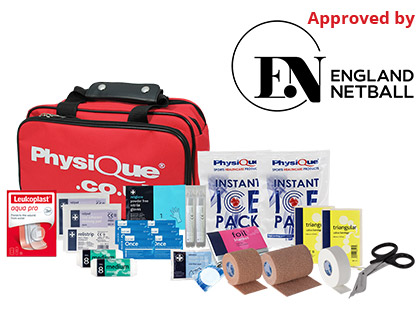
Here are the Injuries listed in the infographic in more depth:
Achilles Tendinopathy - Can occur from force on the Achilles tendon and pain in the back of the heel is a symptom. Physiotherapy can help with recovery, if it is left untreated then it can lead to a rupture which requires surgical intervention.
The Achilles Tendon is quite a complicated part of the body and there are multiple injuries you can incur ranging from tears and tendonitis to ruptures so it is paramount that you contact your physician.
Patella Tendinopathy - Commonly known as Jumper's Knee which alludes to the cause. Jumper's Knee can also refer to Patellar Tendonitis and is also commonly mistaken for Runner's Knee because they both have pain in the front part of the Knee.
We have a guide on Jumper's Knee vs Runner's Knee if you were looking for more information on this.
This is quite common in netball due to the nature of repeatedly jumping and landing during games and training. Symptoms include pain and tenderness in the front part of the knee in or around the knee cap (patella). Physiotherapy and injury management are recommended for proper recovery.
ACL Injuries - As with other sports this is the most common knee ligament injury. Tears and ruptures are possible; this is caused by twisting, landing and pivoting involved in the sport.
Proper rehabilitation is required and ACL injuries should always be taken seriously to avoid further damage or re-injury. an ACL knee support could help with stabilisation.
Shin Splints - Are a RSI that is caused by overuse. Symptoms include pain in the shins but pain varies depending on the injury and person.
The POLICE Principle, especially rest, can help with recovery and treatment and it is not something to worry about too much although it is characterised by pain when walking.
Dislocated Fingers - Possible in any of the finger joints, blocking or catching the ball could cause dislocation but could aulso cause fractures or damage to ligaments and tendons.
X-rays can help diagnose for better treatment, please see Finger Fractures below for more information.
Ankle Sprains - These are caused by running, jumping, and landing. Ankle Roll is another possible source of an Ankle Sprain.
Severity ranges but mild sprains can be addressed with the POLICE Principle and strengthening can help avoid re-injury.
Other Common Netball Injuries:
Rotator Cuff Injuries - The rotator cuff refers to a group of muscles in the shoulder and these types of injuries arise from overuse or misuse of the shoulder.
You are therefore likely to pick up Rotator Cuff injuries from throwing, catching or blocking the ball. Rest and physical therapy can help but more extreme cases might require medical intervention and could need surgery for proper recovery.
Finger Fractures - Usually caused by contact with the ball and as you can imagine, a finger fracture is extremely painful. If someone has assessed an injury to your finger and thinks you have a fracture, the best thing to do is to contact your GP so you can get an x-ray and then get the appropriate treatment and advice if it is indeed a fracture.
Sources and References
[1] Netball Injuries - Downs, C., Snodgrass, S.J., Weerasekara, I. et al. (2021) Injuries in Netball-A Systematic Review. Sports Med - Open 7, 3 (2021). https://doi.org/10.1186/s40798-020-00290-7
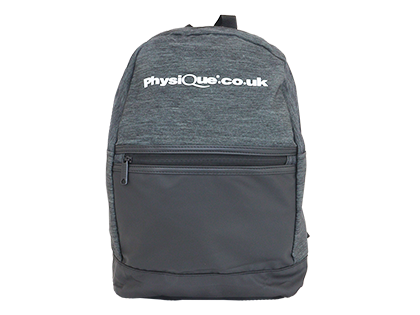
Did you find this article useful?
Why not share this with a colleague, patient or friend?